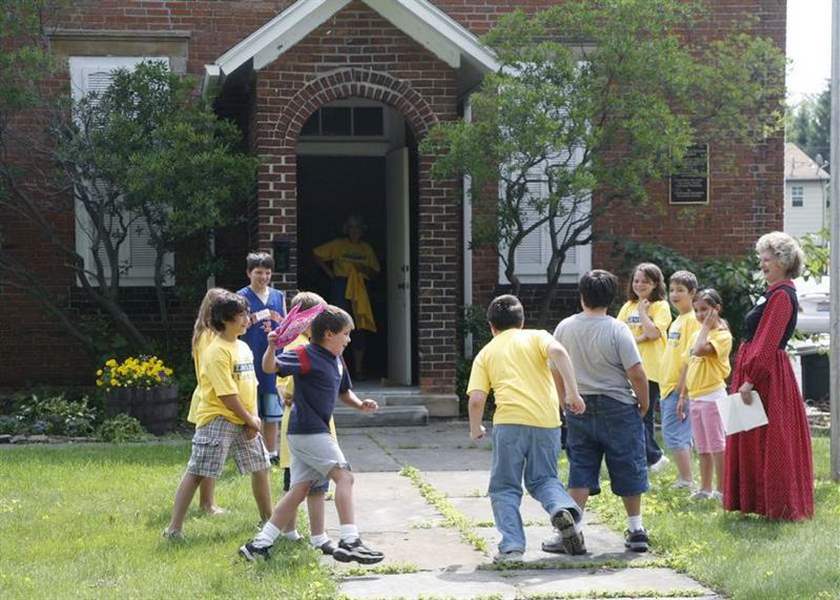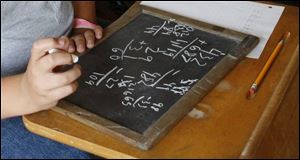
Old-school education in Oregon shows students how pioneers lived
7/2/2008
Teacher Deb Rowland supervises a game of tag at Historic Brandville School.

Teacher Deb Rowland supervises a game of tag at Historic Brandville School.
Nick Krieger, 10, of Oregon was shocked to learn about life in the late 1800s in Ohio.
"I can't believe that they didn't have things like TV," he said.
Children entering grades 3 through 5 were given an opportunity to learn about life in the early days during the Oregon-Jerusalem Historical Society's Living History Day Camp, a four-day program last week at the Historic Brandville School and Museum Complex in Oregon.
The camp featured a different theme each day.
On Tuesday, lessons were taught in a traditional one-room schoolhouse where students practiced cursive writing and did math problems on chalk slates. Activities included outdoor games and a spelling bee. The schoolhouse, dating to the early 1900s, was known as a "sled-house" because it could be put on a sled and moved throughout the townships.

Ben Andrus does a math exercise on a chalk slate.
"It's all about coming to love history and making it come alive for them," said Dianne Powers, one of the camp's two directors.
The camp was divided into morning and afternoon sessions, each with 12 students. Participants had the option of attending one day or the entire four-day camp.
Wednesday's lesson, which centered on Native American culture, was run by Kim Kennedy, the executive director of the American Indian Intertribal Association, and Sherry Shareen, a librarian at Coy Elementary School.
Some of Ms. Kennedy's family lives on the Turtle Mountain Indian Reservation in North Dakota, and her mother, the late Joyce "Snowfeather" Mahaney, founded the nonprofit association, based in Sylvania, in 1988. The organization is dedicated to preservation of Native American cultures.
On Thursday, students played with jacks, stilts, marbles, hoops, and bean bags, and they made a quilt square.
But it wasn't all fun and games.
On Friday, the campers performed 19th century-style chores, including washing diapers with lye soap in a metal tub, putting them through a wringer to squeeze out the water, and then hanging them on a clothesline using old-fashioned clothespins.
Even the snacks were historical. Students made their own lemonade ice cream and butter and learned how to make syllabub, an old-fashioned treat that involves mixing juice with whole milk and sugar.
"In order to have these lessons hit home for the students, the children need to relate what they're learning to real life," said Ms. Shareen.
"It helps them retain what they're learning," she added.
Jeanette Mlynek, a member of the historical society, came up with the idea for the camp with the help of fellow member Ms. Powers. The two had heard about a similar camp at the Wolcott House Museum Complex in Maumee.
Last week's camp was run by Ms. Mlynek and Ms. Powers, with assistance from two volunteer teachers. The camp was held in conjunction with the society's museum, which features a range of northwest Ohio artifacts.
"I loved going upstairs to the museum and getting to see the artifacts," said Lindsey Rikard, 10, of Point Place.
A volunteer docent explained the significance of the historical treasures, and students learned about people such as Victoria Cataract, a member of the Chippewa tribe who lived in a small cabin in Curtice and made her own baskets and grew potatoes, beans, and corn. Ms. Cataract had to walk two miles to get any of the materials she needed. She lived to be 105 years old.
"How do you think she lived to be 105?" asked docent Theresa Berry. She suggested that walking, staying active, and eating healthy foods contributed to Ms. Cataract's longevity.
While this is the camp's first year, Ms. Mlynek said she hoped to make the camp an annual event.
The children will have an opportunity today to show their family and friends the museum and what they learned at the camp.
The museum is on the second floor of the historic Brandville School, built in 1882. On the first floor is meeting space for clubs and other groups.
Local documents, an original painting by American artist Gilbert Gaul depicting the Civil War battle in Cold Harbor, Va., and other items are housed in the museum.
In addition to the museum and one-room schoolhouse, the complex includes a carriage house. An old-time general store, a bedroom, a doctor's office, and other exhibits are featured in the carriage house.
"We focus on artifacts related to the area that are of local significance," said Connie Isbell, president of the society.
The students enjoyed learning about life in an earlier time.
"I love history," said Brian Richmond, 13, of Oregon.
"I wanted to have something to do between baseball and basketball," he added.
During the summer, the museum is open from 2 to 5 p.m. on the second and fourth Thursdays of the month. Admission is free.